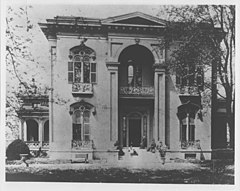Burlington (Nashville, Tennessee)
Burlington, also known as the Elliston-Farrell House, was a historic mansion on a plantation in mid-town Nashville, Tennessee, US. It stood on modern-day Elliston Place.
| Burlington | |
|---|---|
 | |
| Alternative names | Elliston-Farrell House |
| General information | |
| Architectural style | Renaissance architecture |
| Town or city | Nashville, Tennessee |
| Country | United States |
| Completed | 1816; 1859 |
| Demolished | 1932 |
| Client | Joseph Thorpe Elliston; William R. Elliston |
| Design and construction | |
| Architect | William Strickland |
History
The plantation was established by Joseph T. Elliston, a silversmith who served as the fourth mayor of Nashville from 1814 to 1817.[1] In 1811, Elliston purchased 208 acres for $11,435.75 in mid-town, from "what is now 20th Avenue to a line covering part of Centennial Park, and from a line well within the Vanderbilt campus today to Charlotte Avenue."[1] He subsequently purchased 350 acres "along what is now Murphey Road, including the Acklen Park [West End Park] area."[1] It ran across West End Avenue, which had not yet been built.[2]
Elliston built a small house in 1816, and he named it Burlington "after the Elliston homestead in Kentucky."[3] The house stood on modern-day Elliston Place.[4] It was designed by William Strickland in the Renaissance architectural style.[5]
His son William R. Elliston, who served as a member of the Tennessee House of Representatives from 1845 to 1847, inherited the plantation in 1856. With his wife Elizabeth Boddie, he built a bigger house on his father's old house in 1859.[5] The Ellistons were slaveholders.[6]
The plantation was inherited by their daughter, Lizinka. With her husband, Edward Buford, a Confederate veteran, she built a new house in 1887.[7] By 1889, they sold most of the land to the West End Land Company for development.[2][3] Part of the land was also donated to build the campus of Vanderbilt University.[6]
The house was dismantled in 1932.[5] However, the materials were used by the Shepherds, who were descendants of the Ellistons, to build a new mansion called Burlington in Green Hills, designed by architect Bryant Fleming.[4]
In 2012, Vanderbilt University named Elliston Hall for Elizabeth Boddie Elliston.[6] In a 2017 article, USA Today questioned their decision to honor a slaveholder on their campus.[6]
Further reading
- Elliston Farrell, Josephine (1958). Burlington: A Memory. OCLC 10338885.
References
- Davis, Louise (August 14, 1983). "Early Silversmiths Left Marks on City. Names of Elliston, Calhoun Figure Big in Nashville History". The Tennessean. pp. 93–94. Retrieved April 14, 2018 – via Newspapers.com.
- "Staid Elliston Place May Lose Identity". The Tennessean. March 29, 1958. pp. 1, 5. Retrieved April 5, 2018 – via Newspapers.com.
- Thompson, E. D. (March 2, 2016). "The Elliston Family still serves Our Area". The News. Retrieved April 4, 2018.
- Cason, Albert (June 25, 1981). "Mansion Purchased, Opening Way to Luxury Homes". The Tennessean. pp. 1, 5. Retrieved April 4, 2018 – via Newspapers.com.
- Whitsitt Edwards, Amelia (1999). Nashville Interiors, 1866 to 1922. Charleston, South Carolina: Arcadia Publishing. pp. 27–32. ISBN 9780738502205. OCLC 44274945.
- Epstein Ojalvo, Holly (February 13, 2017). "Beyond Yale: These other university buildings have ties to slavery and white supremacy". USA Today. Retrieved April 7, 2018.
- "Edward Buford, Wholesale Firm President, Dies. End Comes At Home On Elliston Place; 86 Years Old". The Tennessean. June 12, 1928. pp. 1, 5. Retrieved April 18, 2018 – via Newspapers.com.